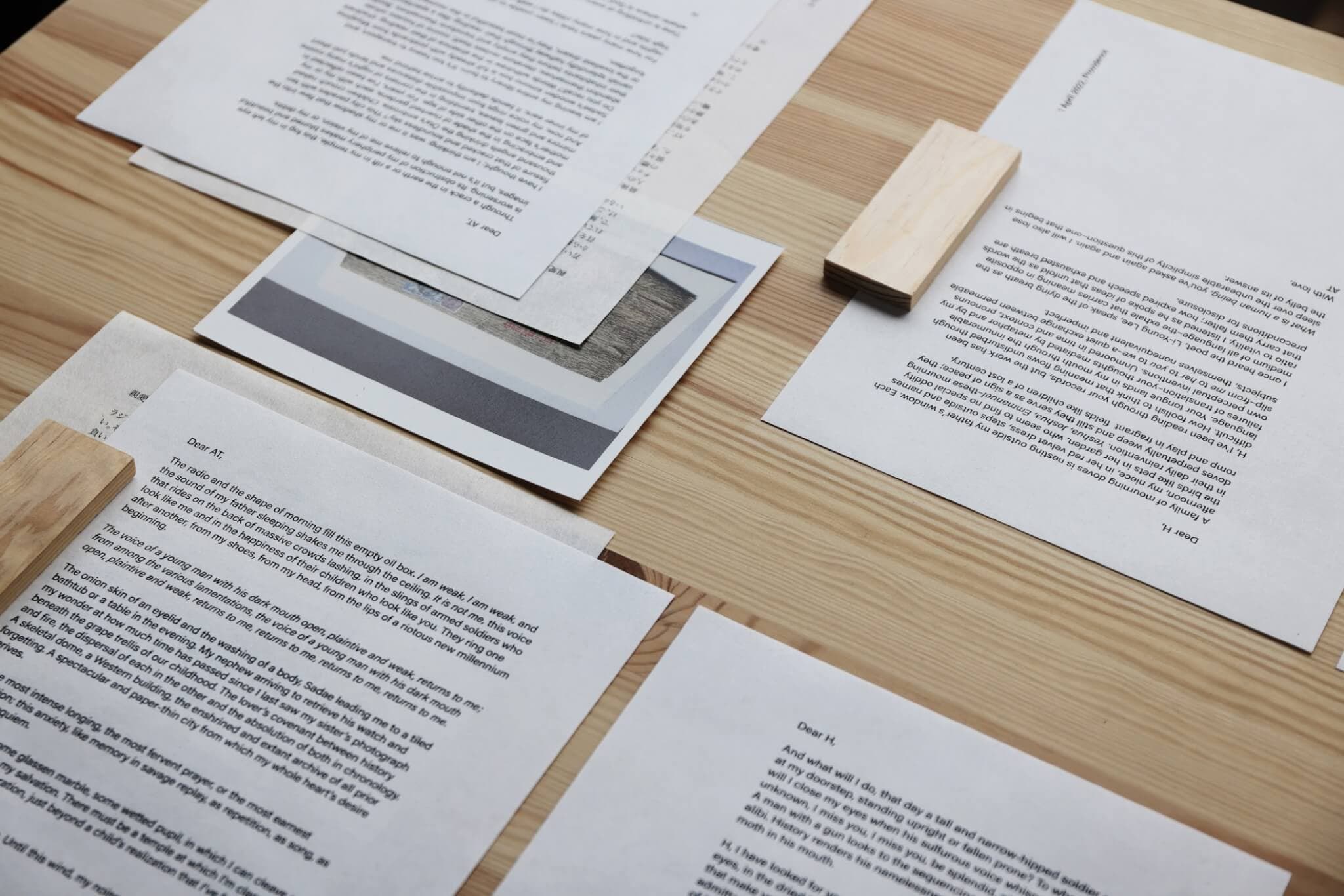In “Dead Letter Room,” a solo exhibition featuring the work of Allie Tsubota at Brookline Arts Center, the artist presents a fictional conversation with the work of late Japanese poet Hara Tamiki. Through letters and photo collages, each work within the small window gallery connects lines of the present with the past. As the exhibition description explains, Hara (1905–1951) wrote poems whose verses suspended time. With most of his writing penned during the pre- and postwar periods, he is perhaps best known for authoring Summer Flowers, a personal account of the bombing of Hiroshima. In the thirteen letters displayed in the show, Tsubota joins Hara in his atemporality, with language that is tangible yet untethered, conveying personal and mass grief and often referencing his tragic death by suicide.
Online• Mar 12, 2024
Tragedies Transcending Time: Allie Tsubota’s “Dead Letter Room” Joins Late Poet Hara Tamiki’s Correspondence with Ghosts
A fictional correspondence between an artist and a late Japanese poet transpires at Brookline Arts Center, connecting the present to the past.
Review by Elisa Rowe
Allie Tsubota, View of Asakusa, Tokyo, 2022. Installation view, “Dead Letter Room,” Brookline Arts Center, Brookline. On view through March 16, 2024.

Allie Tsubota, View of Asakusa, Tokyo, 2022. Installation view, “Dead Letter Room,” Brookline Arts Center, Brookline. On view through March 16, 2024.

Installation view, “Dead Letter Room,” Brookline Arts Center, Brookline. On view through March 16, 2024.
In the exhibit are sets of collages, each in two frames, with whole and fragmented select letters. The writing surrounds one large and several small, vast photos of a city, trains, silhouettes, ruins of former landmarks, or glimpses of nature in Japan, such as a spread of sky above the Atomic Bomb Dome. Their imaginary correspondence is pieced together from the remains of Hara’s literary archives. Penned in 2022 for an exhibition at ARCUS Project Open Studios in Ibaraki, Japan, the messages have Tsubota, as “AT,” and Hara, as “H,” trading rich images of remembrance and time, represented both in full Japanese and English translations. There is a strong sense of longing. The verses ache and mourn through stark images captured in minimalist phrases that nod to the ethereal. Some are traditionally beautiful, like crocuses blooming, and others more haunting, such as the salvaged fingernails of H’s deceased nephew.
Tsubota, who holds an MFA from the Rhode Island School of Design, currently lives in New Jersey and teaches at Parsons School of Design and the College of New Jersey. Her work spans text, photography, and video, often drawing from archives. Despite their separation of time and place, both writers settle on timeless themes like youth, touching on teenage love and encounters with young soldiers. H makes a reference to his young sister’s death from tuberculosis, wondering if she was light enough to float to heaven. Stumbling through their places in time, the pieces leave the viewers upended, searching for relief from the tragedies mentioned, but finding no healing in the resurrected ghosts. Instead, they are encouraged to think of the sensory and corporeal: How did Hara witness his life? Where is he still present? Tsubota brings the viewer into the tragedy of Hara’s death: “I think about soundlessness,” AT writes to H, “and I wonder at which point the echoes of the earth withdrew for you—if within the lag between light and sound you lost the ability to hear.” In another letter, AT mentions that she still thinks about H.

Allie Tsubota’s Letters to/from H and photographs of items held in the collections of the Hiroshima City Chuo Library. Installation view, “Dead Letter Room,” Brookline Arts Center, Brookline. On view through March 16, 2024.
On two tables, the thirteen letters, titled Letters to/from H, are set like placemats. Each piece is dated on the side, stretching throughout the year 2022, and identified by a location, either Providence or Tokyo. Next to or beneath several letters are pictures of some of Hara’s letters and possessions that currently reside in the Hiroshima City Chuo Library. The language in the fictive texts on display follows themes of the temporal, gesturing toward the “fractured,” “fragmented,” and “eternal.” “Minutes stretch onward,” a letter from H reads, “as if mocking infinity and the ability to measure them escapes me.” At other times, Tsubota and Hara both look back to their youth: “After forty years, I still see my boyhood in these waters,” writes Hara of the Ōta river. Each piece sparks rumination, particularly around the mechanisms of history. Hara wonders how his writing will be perceived as he records it, asking, “How will historians describe this dream?” Tsubota reminds the reader how time can be so important to someone, only to have their name later erased in history.
“Dead Letter Room,” in its representation of Hara’s work and references to Hiroshima in the midst of atomic war, is centered on a colossal crime against humanity in the context of empire. The exhibit space itself is narrow, with tables positioned tightly near the glass walls. It could be argued that a work with so much significance, especially considering the continued legacy of imperialism’s violence today, should be on display in a larger location to allow viewers to absorb and reflect on each of the letters. Additionally, a visitor with a mobility aid or stroller would have trouble navigating the exhibit, with the potential for some of the letters to be completely unreachable.
Joining Hara in his realm outside of time, Tsubota creates a conversation not brought out of history but recognized like a ghost sighting. The two trade images of natural beauty, horror, and longing. Her work repeats to Hara that he is still seen, like the deceased in his own writing. “I have looked for you,” writes Tsubota, “in the saddened folds of a grown child’s eyes, in the dried blood on a trimmed blade and in the strokes of lead that make your name.”
The exhibit is a reminder of poetry’s ethereal qualities amidst tragedy, how stanzas exploring images of loss and horror can make time irrelevant. Here we are presented with a terrible truth: there will always be the prevalence of the corporeal and the use of the senses in the midst of grand disaster.
Tsubota’s “Dead Letter Room” is on view at Brookline Arts Center through March 16, 2024.
